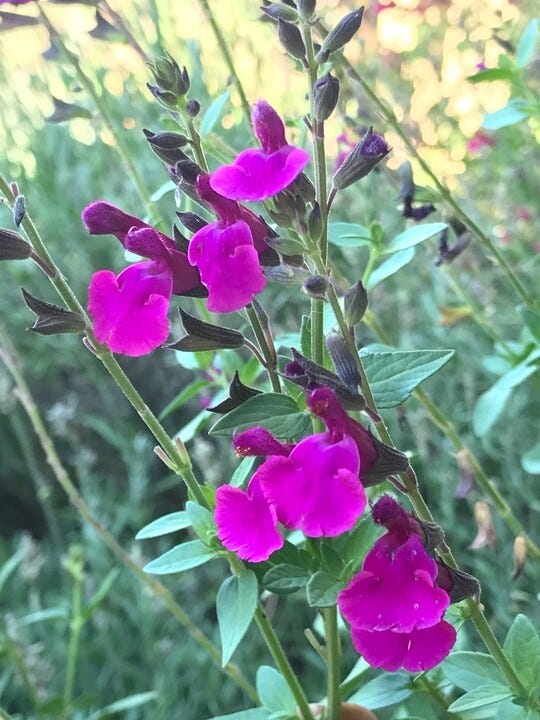Selecting FlowerKisser® Salvia For Nectar-Rich Blooms
By David Salman, High Country Gardens Founder
The genus Salvia, commonly known as Sages, includes a huge number of species from North and South America, Europe, Asia, and Africa. As these plants are native to a huge part of the planet, it’s no surprise that they're a highly variable group, adapted to a wide range of growing climates and conditions.
Salvias have an enthusiastic following among gardeners who enjoy their fantastic range of brightly colored flowers and all the wonderful pollinators that they attract. Species native to North and South America are highly attractive to hummingbirds, which are also native to this same hemisphere. Butterflies, bees, and bumblebees are also attracted to the flowers and are key pollinators for Salvias from all parts of the world.
Salvias are also aromatic, with flowers and foliage scented with natural oils that repel browsing animals such as deer and rabbits. Thus they are an excellent choice in parts of the country where browsing animals are a problem.
FlowerKisser® Plants From David Salman
The FlowerKisser® brand of perennials has been carefully curated by David Salman, High Country Gardens Founder. FlowerKisser® plants are selected for their beautiful flower colors, resilient garden performance in tough growing conditions, and their value to all types of pollinators that feed on their abundant nectar. These new perennial introductions are particularly nectar-rich and attract many pollinators, including honey bees, native bees, butterflies, and hummingbirds.
“Flower kisser” is the translation of the Portuguese word for hummingbird used in Brazil. Brazil is home to more hummingbird species than any other place on the planet!
When you're looking to start a pollinator garden, or expand on your pollinator-friendly plantings, FlowerKisser® perennials are essential for your plant list. Read on to learn more about the selection of FlowerKisser™ Salvias and more from High Country Gardens.

FlowerKisser® Coral-Pink Salvia
Offering nonstop color from late spring through hard frost in fall, FlowerKisser® Coral-Pink Salvia is a flowering machine with large, eye-catching coral-pink flowers. Introduced in 2019, this native selection is a medium-sized shrub that I found growing in a neglected Santa Fe landscape that I often drive past on my way around town. After watching its amazing performance in that hot, dry spot, I took some cuttings and planted them into my test beds, where they grew and flowered robustly. Of course, the hummingbirds love it as it’s never out of flower.
Grow it in well-drained non-clay soil where it will get a full day of hot sun.
Recommended companion plants:

FlowerKisser® Dark Shadows Salvia
A volunteer seedling of Raspberry Delight® that established itself in my home garden, FlowerKisser® Dark Shadows Salvia is a delight as well. Introduced in 2019, its dark flowers and the strong, sweetly aromatic scent of its foliage are highly desirable in the garden. The flowers are nectar-rich and highly attractive to hummingbirds. Rich violet-purple flowers cover this tall woody sage from mid-summer through the hard frosts in fall. It’s a robust shrub maturing to up to 3 feet tall and up to 4 feet wide.
Plant it in well-drained soil (no heavy clay) and give it a full day of hot sun. Being a large grower, strengthen its branch structure with a modest annual pruning in mid-spring.
Recommended companion plants:
- Hummingbird Mint (Agastache)
- Goldenrod (Solidago)
- Black Eyed Susan (Rudbeckia)
- Blonde Ambition Blue Grama grass (Bouteloua ‘Blonde Ambition’) makes an especially handsome ornamental grass companion.
FlowerKisser® Royal Rose Salvia
A new native hybrid sage, FlowerKisser® ‘Royal Rose’ is enjoyed for its sumptuous deep rose pink flowers. This Salvia is an exceptionally long bloomer, attracting pollinating hummingbirds and bumblebees from late spring through early fall. The foliage is delightfully aromatic, releasing a pleasing sweet herbal scent when brushed or touched. It grows up to 3 feet tall and up to 2.5 feet wide. A small-growing woody shrublet, it loves full sun and most soil types, except wet clay.
Grow it in well-drained non-clay soil where it will get a full day of hot sun.
Recommended companion plants:
Learn More About Growing Salvia
- For more information about choosing Salvia plants for your garden, learn more: Planting Nectar Rich Salvia to Attract Pollinators to the Garden
- For tips on growing and care, see our planting guide: How To Grow Salvia
FlowerKisser® Plants From High Country Gardens
Explore our growing selection of beautiful nectar-rich FlowerKisser™ plants from Chief Horticulturist David Salman.




